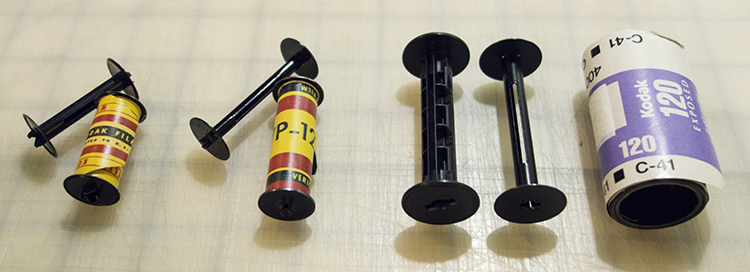18. Film, part 1 |


|
|
FORMAT vs. FORMAT 
From the left: 828, 127, 120, and 620 film spools. |
|
It is rather mind-boggling how many formats have existed since photography got started. Most people are surprised, especially if their experience has been limited to 35mm canisters. There is a lot of excellent internet reading on the subject. It's very interesting from a historical point of view, or if you want to be an informed Ebay shopper, but think of it as "extra credit" rather than required reading. One issue that can be confusing is the difference between film format and camera format. A camera that takes 120 film, which is 6 cm wide, could expose the individual frames at 6x4.5 cm, or 6x6, 6x7, 6x8, 6x9, 6x12, or 6x17 (and I've probably missed something). 6x6 cm (2½ x 2½ inches) is the classic Hasselblad and Rolleiflex square formats. 6x17 cm is the same size as half of a 5x7 inch piece of sheet film. The roll of 120 film itself is the same in every case. One wrinkle: 120 and 620 are the same film size. It is the film spools that are different. Once upon a time, 620 film was available for sale. Today, if you want to shoot commercial film with a 620 camera, you have to re-roll 120 film onto a 620 spool. (At least emulsion makers get to skip that step :-) People often have strong feelings about the best format, but if ever a topic were a matter of "each to his/her own", film format would be it. There is an objective issue, though—the wider the format, the fewer exposures from a roll of film. A 6x4.5 camera will get 15 or 16 exposures from a 120 roll. A 6x17 panorama camera will expose only four frames. As a practical matter, this can influence the decision about film emulsion choice. A small negative will be enlarged more than a larger one for a given print size. A slower emulsion will usually be finer grained, and therefore yield a less "grainy" print (if that is important to you). On the other hand, people often photograph with roll film cameras so that they walk around without a tripod, perhaps necessitating a "fast" film. (A fast lens, on the other hand, means it has a large maximum aperture allowing wide-open shooting, which in turn allows slower film and/or low light situations.) Obviously, there are no right or wrong choices — just the necessity of understanding the characteristics of the tools and materials and the related trade-offs as they pertain to your goals. One word of (hard-earned!) advice: Beware G.A.S. (Gear Acquisition Syndrome)—at least in the beginning. There are no magic bullets. No magic camera brands or soups of chemistry. But there will be magic. I'll always be pretty sure that what happens when a photon hits a silver halide crystal is Magic. Start with one or two cameras, preferably the ones you already own. Learn to make emulsions. Emulsion doesn't know Hasselblad from Holga. Learn to photograph with your emulsions. Practice, practice, practice. And read. And think. Imagine a circular staircase taking you higher with each loop. One year from now, you will be amazed at your progress. And, yes, you'll probably spend a little money (or a lot!) on Ebay, but it will be happy money and not groan money. |

|
|
The Docks. Newport, Oregon. Continued... |